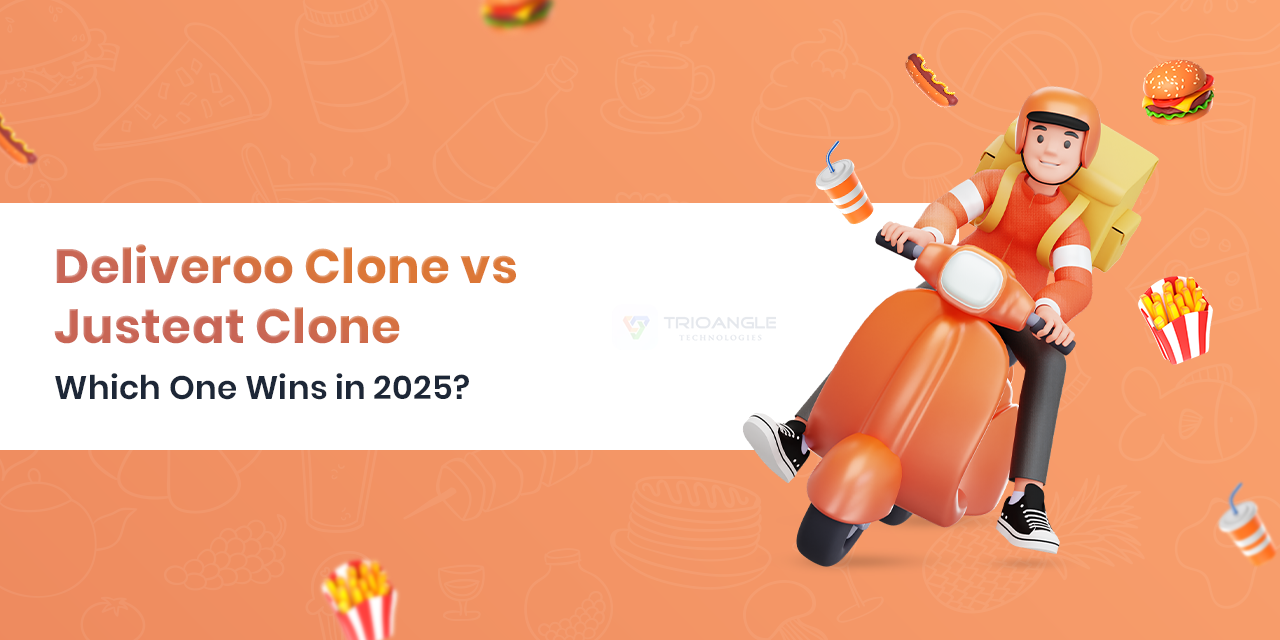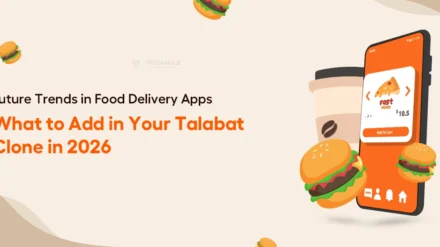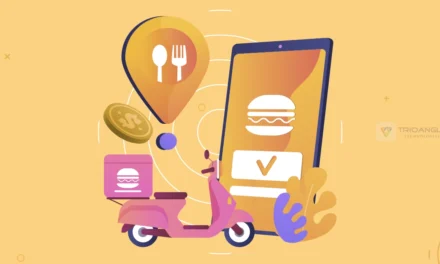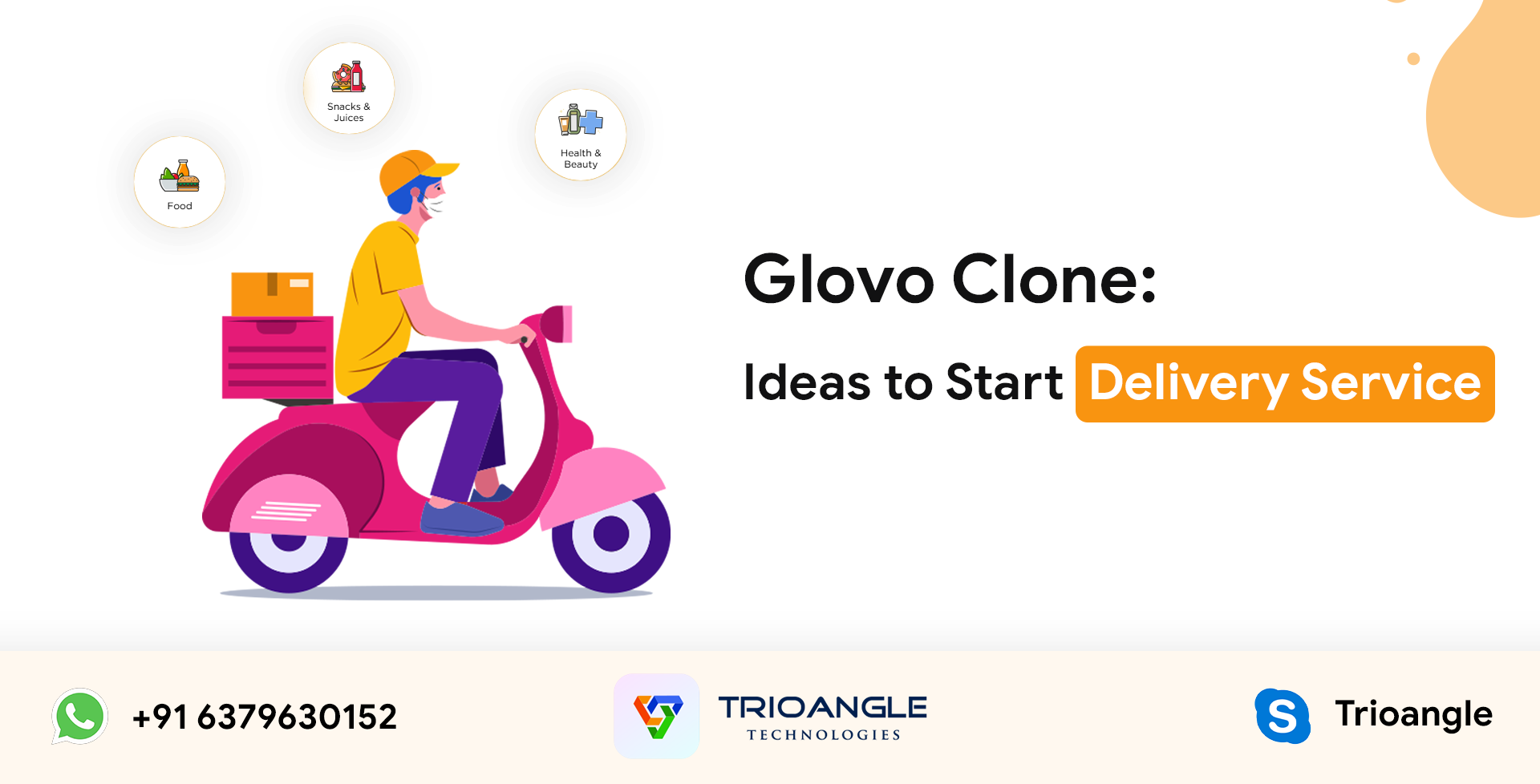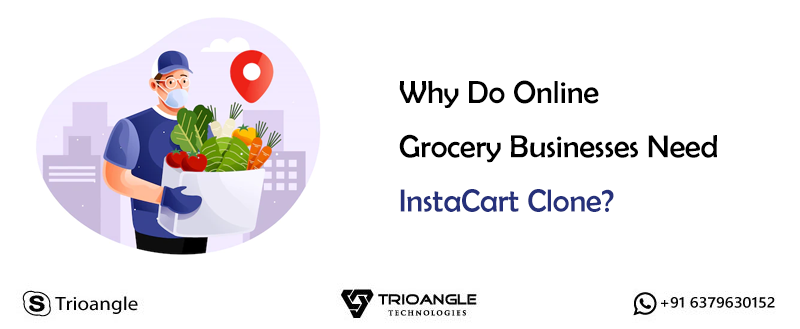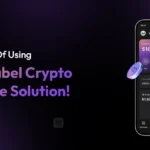The future of food delivery business is evolving rapidly, driven by cutting-edge technologies and ever-changing consumer expectations. As 2025 unfolds, businesses embrace transformation to stay competitive in the food tech space. From AI-powered ordering to drone-based deliveries, the world of food delivery is undergoing a digital revolution.
Entrepreneurs have started to build food delivery clone apps to enter the market quickly and reach the target audience. Deliveroo Clone and Justeat Clone stand out in the competitive market set industry, offering powerful features and proven business models.
The options are clear, but which aligns best with your vision? In this comparison, we’ll break down the differences between Deliveroo and Justeat clone to help you decide which delivery clone app is the smarter investment for your food delivery venture. Let’s examine the unique contrast between Deliveroo and Just Eat clone apps, which stand out in the market.
Detailed Phase Comparison of Deliveroo Clone and Justeat Clone
Finding the top food delivery clone applications that stand out in the crowded market in 2025 is extremely difficult. Let’s see and evaluate the contrast of every phase to find out which clone app wins the race.
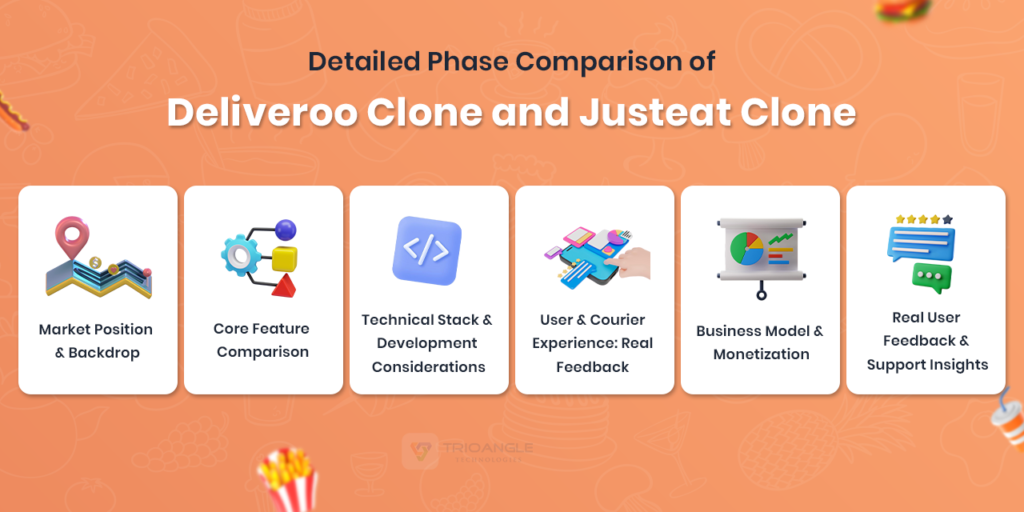
> Market Position & Backdrop
The global food delivery industry is expected to exceed $500 billion by 2025, with digital platforms playing a key role in shaping consumer behavior.
Although they employ different approaches, Deliveroo and JustEat remain the leading players in the European market. Let’s have a look at the market positions of both food delivery clone apps.
Deliveroo Clone
As of 2025, Deliveroo and JustEat stand as the two dominant players in the highly competitive food delivery platform market. Deliveroo operates in over 200 cities worldwide and collaborates with local restaurants to offer a diverse range of cuisines. Globally, it now has 7.1 million active users.
Deliveroo clone revenue, currently at £2.03 billion, is projected to grow steadily to over £2.25 billion by 2025. A Deliveroo clone targets urban areas with dense tech-savvy customers, emphasizing fast delivery through a proprietary fleet of couriers and real-time logistics management.
This model appeals to markets prioritizing speed and premium service experiences. A Deliveroo clone usually demands a larger technological investment but provides enhanced control over delivery quality.
Justeat Clone
The online meal delivery app market, encompassing JustEat clone, is expected to grow rapidly, reaching $429.95 billion by 2025. This surge presents a significant opportunity for entrepreneurs to enter the food delivery sector.
In contrast, a JustEat clone primarily operates as a marketplace connecting consumers with restaurants that typically manage their own deliveries. This strategy is more scalable, has fewer operating costs, and works well in areas with sparser populations.
Justeat gains from quick growth and increased restaurant coverage, but it frequently struggles to maintain consistent delivery standards. Different market demands and investment goals are reflected in both models, which help to shape their unique competitive positions.
> Core Feature Comparison
The key features of Deliveroo and Just Eat clones vary greatly, particularly in logistics, user control, and the complexity of their operations.
Deliveroo Clone
The Deliveroo clone focuses on taking total control of the delivery process by managing its fleet of messengers. Among its key features like payment gateways, dynamic order dispatching, advanced fleet management with route optimisation, and real-time GPS tracking provide smooth user experiences with order updates and speedy delivery times.
They offer subscription models targeting high-demand metropolitan areas and expand their services to other sectors such as groceries and alcohol delivery.
Justeat Clone
The primary function of the Justeat clone is to serve as a marketplace, connecting customers with restaurants that use outside couriers to deliver goods. Instead of logistics, its main features concentrate on order processing, menu management, and restaurant onboarding. Real-time courier tracking is minimal or optional.
The platform charges commissions on orders but does not manage deliveries, making it easier to scale with lower operational costs. It’s suited for areas with dispersed populations or less-developed delivery infrastructure.
The Deliveroo clone offers enhanced delivery control and a superior customer experience but comes with higher operating costs, whereas JustEat prioritizes scalability by outsourcing logistics to restaurants.
> Technical Stack & Development Considerations
Building a food delivery platform, whether a Deliveroo clone or a Justeat clone, requires a robust and secure tech stack. The development approach depends heavily on the delivery model and operational complexity of the chosen clone type.
Frontend Technology
- Web: React.js, Vue.js, or Angular.
- Mobile: React Native, Flutter, or Swift (iOS) and Kotlin (Android).
- Considerations:
A Deliveroo clone needs real-time order and courier tracking, requiring more dynamic interfaces. - Justeat clone relies on simpler, menu-focused UIs with order status updates.
Backend Technology
- Node.js, Django (Python), Ruby on Rails, or Laravel (PHP)
- GraphQL or REST APIs for communication
- Considerations:
- Deliveroo clone demands high-performance APIs for managing orders, couriers, and routing.
- Justeat clone script allows you to have lighter load needs, mostly around order management and partner communication.
Real-Time Features
- Socket.io, Firebase, or PubNub for:
- Live courier tracking
- Order status updates
- Chat between the customer, the restaurant, and the courier
- Essential for Deliveroo clone; optional or minimal for Just Eat-style platforms.
The Deliveroo clone requires a more complex and logistics-intensive infrastructure. Expect increased development expenses, intricate technical demands, and challenges in scaling.
Ensure your choice of Justeat clone script enables you to integrate this real-time feature in your food delivery app that offers a quicker and less expensive way to produce because of its simpler architecture, which emphasises restaurant integration and user-friendliness.
> User & Courier Experience: Real Feedback
The business model and operational framework of the food delivery app result in a user-friendly experience. Real feedback from users and couriers highlights these differences, shedding light on strengths and pain points unique to each approach.
Deliveroo Clone
User gets a shock of its deliveroo clone reliability and transparency. It provides real-time tracking availability from the order placement to the delivery process. This reduces the uncertainty and builds user trust.
With features like live courier position, projected arrival time, and simple customer support chat options, the Deliveroo clone app layout is usually slick and quite interactive. Consistent delivery quality is frequently mentioned by customers as a significant benefit. Skilled couriers handle food according to stringent criteria, which improves packaging and expedites delivery.
Deliveroo clones frequently offer premium features like membership plans to enhance customer loyalty. Compared to gig-only marketplaces, couriers on these platforms often report feeling more supported.
Since the platform manages its riders, couriers receive improved training, performance incentives, and sometimes additional benefits like insurance or bonuses. By minimising downtime, real-time route optimisation raises hourly wages.
However, couriers a subject to stringent performance goals and restricted order acceptance options, which lead to stress during peak hours. Some riders voice worries about expenses they incur that have an impact on their net income.
Justeat Clone
The Justeat clone platform acts as a marketplace without handling delivery, giving users access to a wide range of eateries and reasonable costs. Reduced delivery fees and the opportunity to order from local favourites that utilise their own couriers or third-party delivery services.
However, the user experience suffers due to inconsistent delivery quality and timing. Because restaurants handle deliveries, real-time tracking is limited. Customer complaints about faulty orders are addressed through the platform.
The Justeat clone app layout tends to prioritise restaurant ratings and menu browsing over real-time order tracking, which caters to consumers who value variety over speed of delivery. Instead of working for the site itself, couriers for the Justeat clone typically work independently for specific eateries.
Although users enjoy greater control over their schedules, they receive less direct support from the platform. Deliveroo clone distinguish themselves by delivering premium and reliable service to both customers and couriers, despite involving more complex operations.
Conversely, this food delivery clone offers a wider selection of restaurants and more competitive pricing but tends to provide a less consistent experience due to reduced control over courier management and delivery reliability.
> Business Model & Monetization
Deliveroo and JustEat clone mainly differ in their delivery methods, which shape their business models and monetization strategies. While both serve as intermediaries connecting customers and restaurants, they adopt distinct approaches to revenue generation and business growth.
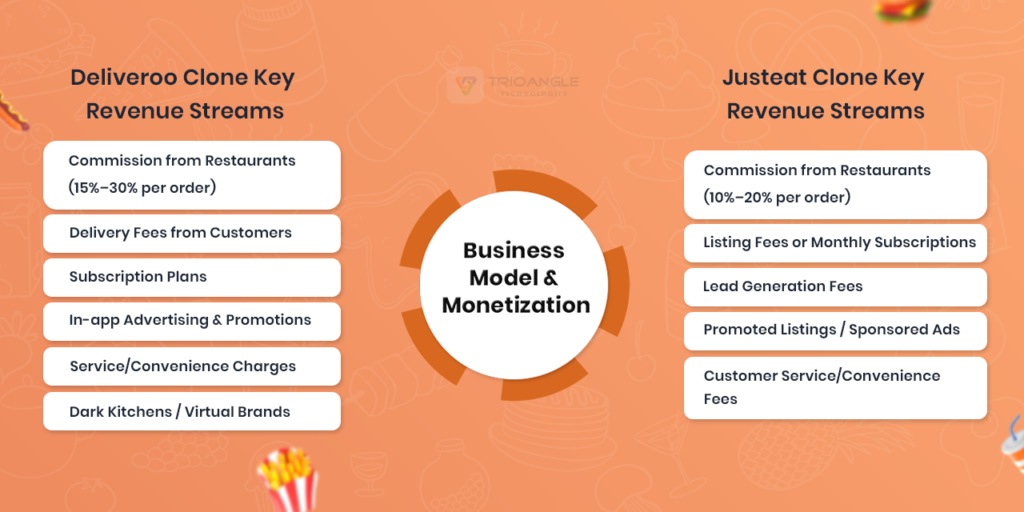
Deliveroo Clone
The Deliveroo clone business model centers on logistics, linking customers with restaurants and managing the entire delivery process.
Providing end-to-end service reliability, managing real-time logistics, and employing a fleet of delivery riders are all part of this strategy.
Key Revenue Streams:
- Commission from Restaurants (15%–30% per order)
- Delivery Fees from Customers: Variable depending on distance, time, or demand.
- Subscription Plans: Monthly fee for perks like free delivery or priority service.
- In-app Advertising & Promotions: Featured restaurant listings, sponsored offers.
- Service/Convenience Charges: Small fees added per transaction
- Dark Kitchens / Virtual Brands: Revenue from operating or renting cloud kitchen spaces.
Justeat Clone
Just Eat clone operates as an aggregation platform, listing restaurants, collecting customer orders, and forwarding them to the respective restaurants, which typically handle the delivery themselves.
The platform lowers complexity and expenses by not controlling the delivery fleet.
Key Revenue Streams:
- Commission from Restaurants (10%–20% per order)
- Listing Fees or Monthly Subscriptions: Restaurants pay to stay listed or unlock premium features.
- Lead Generation Fees: Optional paid leads or priority placement.
- Promoted Listings / Sponsored Ads: Restaurants pay for higher visibility in search results.
- Customer Service/Convenience Fees: Small additional charges on orders.
> Real‑User Feedback & Support Insights
Examining real user reviews and support data is essential when comparing a JustEat clone to a Deliveroo clone, as it uncovers how both customers and service providers view the platform’s responsiveness and dependability.
“These insights have a direct influence on brand loyalty and customer retention.
Deliveroo Clone
Deliveroo clone platforms typically offer email or live chat assistance around the clock, and users value prompt response times. A well-structured support system featuring chatbots, escalation paths, and issue reporting helps maintain user trust.
It provides a dedicated courier service, which includes payout reports, performance assessments, and live assistance. Feedback indicates that couriers would rather have their disputes resolved more quickly and have more transparent information about their earnings.
Justeat Clone
JustEat clones frequently offer decentralized or limited customer support, leading to slower resolution times. Some customers face difficulties with refunds or order issues, especially when responsibility is shifted to the restaurants.
Because couriers are typically not directly connected to the platform, most support responsibilities fall on the restaurants, making it difficult for the platform to ensure a positive experience for riders. In contrast, the Deliveroo clone demands a more robust support system while delivering a more advanced and controlled customer experience.
Justeat clone is easier to launch and expand its business effectively by fulfilling user satisfaction.
Figured Out The Best Food Delivery App!
In the 2025 food delivery landscape, Deliveroo and JustEat clone platforms hold strong positions, with their success largely driven by how well they meet customer expectations, manage operations, and align with market demands.
Deliveroo clone is successful in upscale, metropolitan regions where consumers value speed, dependability, real-time tracking, and a smooth online experience.
By managing logistics directly, these platforms offer improved brand control and higher service quality. Nevertheless, this approach demands greater upfront investment, sophisticated technology, and ongoing oversight of delivery operations.
Start To Launch Your Food Delivery Clone App Right Now in Top Countries!

